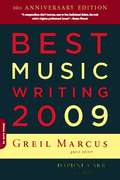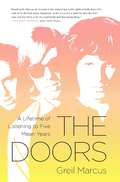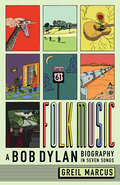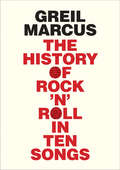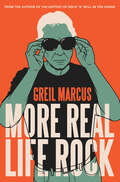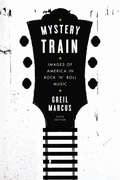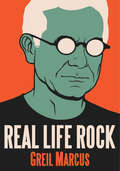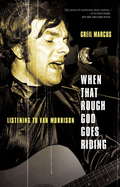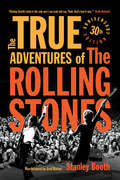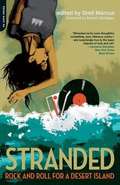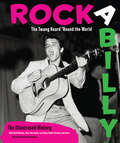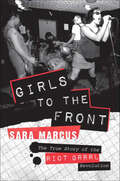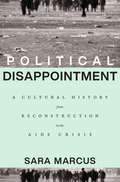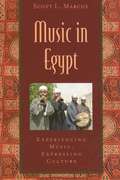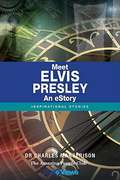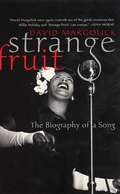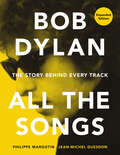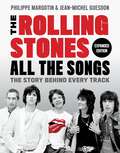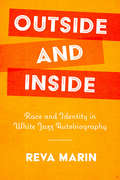- Table View
- List View
Best Music Writing 2009
by Greil MarcusLegendary critic Greil Marcus takes the helm for the landmark tenth edition of Da CapoOCOs annual compendium of the best in music writing"
The Doors: A Lifetime of Listening to Five Mean Years
by Greil MarcusA fan from the moment the Doors’ first album took over KMPX, the revolutionary FM rock & roll station in San Francisco, Greil Marcus saw the band many times at the legendary Fillmore Auditorium and the Avalon Ballroom in 1967. Five years later it was all over. Forty years after the singer Jim Morrison was found dead in Paris and the group disbanded, one could drive from here to there, changing from one FM pop station to another, and be all but guaranteed to hear two, three, four Doors songs in an hour-every hour. Whatever the demands in the music, they remained unsatisfied, in the largest sense unfinished, and absolutely alive. There have been many books on the Doors. This is the first to bypass their myth, their mystique, and the death cult of both Jim Morrison and the era he was made to personify, and focus solely on the music. It is a story untold; all these years later, it is a new story.
Folk Music: A Bob Dylan Biography in Seven Songs
by Greil MarcusAcclaimed cultural critic Greil Marcus tells the story of Bob Dylan through the lens of seven penetrating songs &“Marcus delivers yet another essential work of music journalism.&”—Kirkus Reviews (starred review) &“Just as Dylan allows a song to carry him away, readers will be transported by the sheer poetry of Marcus&’ prose.&”—June Sawyers, Booklist (starred review) &“Further elevates Marcus to what he has always been: a supreme artist-critic.&”—Hilton Als Across seven decades, Bob Dylan has been the first singer of American song. As a writer and performer, he has rewritten the national songbook in a way that comes from his own vision and yet can feel as if it belongs to anyone who might listen. In Folk Music, Greil Marcus tells Dylan&’s story through seven of his most transformative songs. Marcus&’s point of departure is Dylan&’s ability to &“see myself in others.&” Like Dylan&’s songs, this book is a work of implicit patriotism and creative skepticism. It illuminates Dylan&’s continuing presence and relevance through his empathy—his imaginative identification with other people. This is not only a deeply felt telling of the life and times of Bob Dylan but a rich history of American folk songs and the new life they were given as Dylan sat down to write his own.
History of Rock 'n' Roll in Ten Songs
by Greil MarcusThe legendary critic and author of Mystery Train &“ingeniously retells the tale of rock and roll&” (Publishers Weekly, starred review). Unlike previous versions of rock &’n&’ roll history, this book omits almost every iconic performer and ignores the storied events and turning points everyone knows. Instead, in a daring stroke, Greil Marcus selects ten songs and dramatizes how each embodies rock &’n&’ roll as a thing in itself, in the story it tells, inhabits, and acts out—a new language, something new under the sun. &“Transmission&” by Joy Division. &“All I Could Do Was Cry&” by Etta James and then Beyoncé. &“To Know Him Is to Love Him,&” first by the Teddy Bears and almost half a century later by Amy Winehouse. In Marcus&’s hands these and other songs tell the story of the music, which is, at bottom, the story of the desire for freedom in all its unruly and liberating glory. Slipping the constraints of chronology, Marcus braids together past and present, holding up to the light the ways that these striking songs fall through time and circumstance, gaining momentum and meaning, astonishing us by upending our presumptions and prejudices. This book, by a founder of contemporary rock criticism—and its most gifted and incisive practitioner—is destined to become an enduring classic. &“One of the epic figures in rock writing.&”—The New York Times Book Review &“Marcus is our greatest cultural critic, not only because of what he says but also, as with rock-and-roll itself, how he says it.&”—The Washington Post Winner of the Deems Taylor Virgil Thomson Award in Music Criticism, given by the American Society of Composers, Authors & Publishers
Lipstick Traces
by Greil MarcusGreil Marcus, author of Mystery Train, widely acclaimed as the best book ever written about America as seen through its music, began work on this new book out of a fascination with the Sex Pistols: that scandalous antimusical group, invented in London in 1975 and dead within two years, which sparked the emergence of the culture called punk. âeoeI am an antichrist!âe#157; shouted singer Johnny Rottenâe"where in the world of pop music did that come from? Looking for an answer, with a high sense of the drama of the journey, Marcus takes us down the dark paths of counterhistory, a route of blasphemy, adventure, and surprise. This is no mere search for cultural antecedents. Instead, what Marcus so brilliantly shows is that various kinds of angry, absolute demandsâe"demands on society, art, and all the governing structures of everyday lifeâe"seem to be coded in phrases, images, and actions passed on invisibly, but inevitably, by people quite unaware of each other. Marcus lets us hear strange yet familiar voices: of such heretics as the Brethren of the Free Spirit in medieval Europe and the Ranters in seventeenth-century England; the dadaists in Zurich in 1916 and Berlin in 1918, wearing death masks, chanting glossolalia; one Michel Mourre, who in 1950 took over Easter Mass at Notre-Dame to proclaim the death of God; the Lettrist International and the Situationist International, small groups of Parisâe"based artists and writers surrounding Guy Debord, who produced blank-screen films, prophetic graffiti, and perhaps the most provocative social criticism of the 1950s and âe(tm)60s; the rioting students and workers of May âe(tm)68, scrawling cryptic slogans on city walls and bringing France to a halt; the Sex Pistols in London, recording the savage âeoeAnarchy in the U. K. âe#157; and âeoeGod Save the Queen. âe#157;Although the Sex Pistols shape the beginning and the end of the story, Lipstick Traces is not a book about music; it is about a common voice, discovered and transmitted in many forms. Working from scores of previously unexamined and untranslated essays, manifestos, and filmscripts, from old photographs, dada sound poetry, punk songs, collages, and classic texts from Marx to Henri Lefebvre, Marcus takes us deep behind the acknowledged events of our era, into a hidden tradition of moments that would seem imaginary except for the fact that they are real: a tradition of shared utopias, solitary refusals, impossible demands, and unexplained disappearances. Written with grace and force, humor and an insistent sense of tragedy and danger, Lipstick Traces tells a story as disruptive and compelling as the century itself.
More Real Life Rock: The Wilderness Years, 2014†“2021
by Greil MarcusA funny, fierce, and uninhibited musical chronicle of the convulsive past six years from one of our finest cultural critics "A one-of-a-kind guide to rock music’s resonance in every aspect of our lives.”—David Kirby, Wall Street Journal “A smart set of suggestions for further reading, viewing, and listening by a most trustworthy guide.”—Kirkus Reviews For the past thirty-five years, celebrated author Greil Marcus has applied his unmatched critical apparatus to everything from music, television, radio, and politics to overheard comments, advertisements, and happenstance street encounters—an eclectic collection of what he calls “everyday culture and found objects.” This book collects hundreds of items from the crisscrossing spectrum of culture and politics throughout the tumultuous past six years of American life, an essential travel guide to the scorched landscape of recent history. Tracking the evolution of national identity during the Trump administration, Marcus spotlights the most whip-smart cultural artifacts to compose a mosaic portrait of American society, replete with unexpected heroes and villains, absurdity and its consequences, humor and despair, terror and defiance—as seen through media, music, and more. Bursting with Marcus’s effortless, no-nonsense, unapologetic verve, this book features seventy-three columns from 2014 through February 2021.
Mystery Train
by Greil MarcusIn 1975, Greil Marcus's Mystery Train changed the way readers thought about rock 'n' roll and continues to be sought out today by music fans and anyone interested in pop culture. Looking at recordings by six key artists--Robert Johnson, Harmonica Frank, Randy Newman,the Band, Sly Stone, and Elvis Presley--Marcus offers a complex and unprecedented analysis of the relationship between rock 'n' roll and American culture. In this latest edition, Marcus provides an extensively updated and rewritten Note and Discographies section, exploring the recordings' evolution and continuing impact.
Mystery Train
by Greil MarcusCatch a train to the heart of rock ?n? roll with this essential study of the quintessential American art form. First published in 1975, Greil Marcus?s Mystery Train remains a benchmark study of rock ?n? roll and a classic in the field of music criticism. Focusing on six key artists?Robert Johnson, Harmonica Frank, Randy Newman, the Band, Sly Stone, and Elvis Presley?Marcus explores the evolution and impact of rock ?n? roll and its unique place in American culture. This fifth edition of Mystery Train includes an updated and rewritten Notes and Discographies section, exploring the evolution and continuing impact of the recordings featured in the book.
Real Life Rock
by Greil MarcusFor nearly thirty years, Greil Marcus has written a remarkable column called "Real Life Rock Top Ten. " It has been a laboratory where he has fearlessly explored and wittily dissected an enormous variety of cultural artifacts, from songs to books to movies to advertisements. Taken together, his musings, reflections, and sallies amount to a subtle and implicit theory of how cultural objects fall through time and circumstance and often deliver unintended consequences, both in the present and in the future. Real Life Rock reveals the critic in full: direct, erudite, funny, fierce, vivid, uninhibited, and possessing an unerring instinct for art and fraud. The result is an indispensable volume packed with startling arguments and casual brilliance.
Three Songs, Three Singers, Three Nations
by Greil MarcusGreil Marcus delves into three distinct episodes in the history of American commonplace song and shows how each one manages to convey the uncanny sense that it was written by no one. In these seemingly anonymous productions, we discover three different ways of talking about the United States, and three separate nations within its borders.
When That Rough God Goes Riding: Listening to Van Morrison
by Greil Marcus"Van Morrison," says Greil Marcus, "remains a singer who can be compared to no other in the history of modern popular music. " When Astral Weeks was released in 1968, it was largely ignored.<P><P> When it was rereleased as a live album in 2009 it reached the top of the Billboard charts, a first for any Van Morrison recording. The wild swings in the music, mirroring the swings in Morrison's success and in people's appreciation (or lack of it) of his music, make Van Morrison one of the most perplexing and mysterious figures in popular modern music, and a perfect subject for the wise and insightful scrutiny of Greil Marcus, one of America's most dedicated cultural critics. This book is Marcus's quest to understand Van Morrison's particular genius through the extraordinary and unclassifiable moments in his long career, beginning in 1965 and continuing in full force to this day. In these dislocations Marcus finds the singer on his own artistic quest precisely to reach some extreme musical threshold, the moments that are not enclosed by the will or the intention of the performer but which somehow emerge at the limits of the musician and his song.
The True Adventures of Rolling Stones
by Greil Marcus Stanley BoothStanley Booth, a member of the Rolling Stones' inner circle, met the band just a few months before Brian Jones drowned in a swimming pool in 1968. He lived with them throughout their 1969 tour across the United States, staying up all night together listening to blues, talking about music, ingesting drugs, and consorting with groupies. His thrilling account culminates with their final concert at Altamont Speedway--a nightmare of beating, stabbing, and killing that would signal the end of a generation's dreams of peace and freedom. But while this book renders in fine detail the entire history of the Stones, paying special attention to the tragedy of Brian Jones, it is about much more than a writer and a rock band. It has been called--by Harold Brodkey and Robert Stone, among others--the best book ever written about the 1960s. In Booth's afterword, he finally explains why it took him 15 years to write the book, relating an astonishing story of drugs, jails, and disasters. Updated to include a foreword by Greil Marcus, this 30th anniversary edition is for Rolling Stones fans everywhere.
Stranded: Rock and Roll for a Desert Island
by Greil Marcus Robert ChristgauIn 1978, Greil Marcus asked twenty writers on rock-including Dave Marsh, Lester Bangs, Nick Tosches, Ellen Willis, and Robert Christgau-a question: What one rock-and-roll album would you take to a desert island? The resulting essays were collected in Stranded, twenty passionate declarations to such albums as The Rolling Stones' Beggars Banquet, the Ramones' Rocket to Russia, Something Else by the Kinks, and more. Universally revered as the ur-text of rock journalism, Stranded is an indispensable classic.
Rockabilly: The Illustrated History
by Greil Marcus Peter Guralnick Luc Sante Robert GordonIt was the twang heard 'round the world: Rockabilly was born out of country, bluegrass, jazz, and the blues in the 1950s, becoming rock &’n&’ roll and ruling the world. Here&’s the story of Elvis Presley&’s first Sun records that inspired all. And here&’s Carl Perkins, Gene Vincent, Eddie Cochran, Jerry Lee Lewis, Johnny Cash, Roy Orbison, and many more rockabillies from the golden years of 1955–1959, in a book chock full of photos, collectible memorabilia, movie posters, rare records, fashion, and rebel lifestyle. Includes contributions from noted music journalists Greil Marcus, Peter Guralnick, Luc Sante, Robert Gordon, and more. The story continues today, with a rockabilly revival that began with stars, such as the Stray Cats and Robert Gordon, spreading around the globe from Europe to Japan. Today, rockabilly is better than ever, with bands like Rev. Horton Heat and others playing the music and living the life from Memphis to Helsinki to Tokyo. There&’s still good rockin&’ tonight!
Schoenberg and Hollywood Modernism
by Kenneth H. MarcusSchoenberg is often viewed as an isolated composer who was ill-at-ease in exile. In this book Kenneth H. Marcus shows that in fact Schoenberg's connections to Hollywood ran deep, and most of the composer's exile compositions had some connection to the cultural and intellectual environment in which he found himself. He was friends with numerous successful film industry figures, including George Gershwin, Oscar Levant, David Raksin and Alfred Newman, and each contributed to the composer's life and work in different ways: helping him to obtain students, making recordings of his music, and arranging commissions. While teaching at both the University of Southern California and the University of California, Los Angeles, Schoenberg was able to bridge two utterly different worlds: the film industry and the academy. Marcus shows that alongside Schoenberg's vital impact upon Southern California Modernism through his pedagogy, compositions and texts, he also taught students who became central to American musical modernism, including John Cage and Lou Harrison.
Girls to the Front: The True Story of the Riot Grrrl Revolution
by Sara Marcus“Not only a historical rockument of the revolutionary 90s counterculture Riot Grrrl movement. . . but also a rousing inspiration for a new generation of empowered rebel girls to strap on guitars and stick it to The Man.” — Vanity FairGirls to the Front is the epic, definitive history of the Riot Grrrl movement—the radical feminist punk uprising that exploded into the public eye in the 1990s, altering America’s gender landscape forever. Author Sara Marcus, a music and politics writer for Time Out New York, Slate.com, Pos, and Heeb magazine, interweaves research, interviews, and her own memories as a Riot Grrrl front-liner. Her passionate, sophisticated narrative brilliantly conveys the story of punk bands like Bikini Kill, Bratmobile, Heavens to Betsy—as well as successors like Sleater-Kinney, Partyline, and Kathleen Hanna’s Le Tigre—and their effect on today’s culture.
Political Disappointment: A Cultural History from Reconstruction to the AIDS Crisis
by Sara Marcus“Political Disappointment is an abundant text, overflowing with Sara Marcus’s considerable gifts. She is adept at presenting history and narrative with equal clarity; her writing is urgent but also optimistic. This is a book that is sometimes painful but never sacrifices hope or beauty.”—Hanif AbdurraqibMoving from the aftermath of Reconstruction through the AIDS crisis, a new cultural history of the United States shows how artists, intellectuals, and activists turned political disappointment—the unfulfilled desire for change—into a basis for solidarity.Sara Marcus argues that the defining texts in twentieth-century American cultural history are records of political disappointment. Through insightful and often surprising readings of literature and sound, Marcus offers a new cultural history of the last century, in which creative minds observed the passing of moments of possibility, took stock of the losses sustained, and fostered intellectual revolutions and unexpected solidarities.Political Disappointment shows how, by confronting disappointment directly, writers and artists helped to produce new political meanings and possibilities. Marcus first analyzes works by W. E. B. Du Bois, Charles Chesnutt, Pauline Hopkins, and the Fisk Jubilee Singers that expressed the anguish of the early Jim Crow era, during which white supremacy thwarted the rebuilding of the country as a multiracial democracy. In the ensuing decades, the Popular Front work songs and stories of Lead Belly and Tillie Olsen, the soundscapes of the civil rights and Black Power movements, the feminist poetry of Audre Lorde and Adrienne Rich, and the queer art of Marlon Riggs and David Wojnarowicz continued building the century-long archive of disappointment. Marcus shows how defeat time and again gave rise to novel modes of protest and new forms of collective practice, keeping alive the dream of a better world.Disappointment has proved to be a durable, perhaps even inevitable, feature of the democratic project, yet so too has the resistance it precipitates. Marcus’s unique history of the twentieth century reclaims the unrealized desire for liberation as a productive force in American literature and life.
Music in Egypt: Experiencing Music, Expressing Culture
by Scott L. MarcusThis book is a case study in the Global Music series, edited by Bonnie Wade and Patricia Campbell. The book focuses on the variety of music that fill the eastern Arab world, with special focus on musics found in modern day Egypt. Based on his extensive fieldwork, Marcus introduces the features that unify much of Middle Eastern music. The book highlights the dynamic nature of Middle Eastern music culture and also explores the impact of modernization and westernization on musical culture as well as music's role in helping to create a regional, national, and community identity. The three themes focused upon are the concepts of melodic and rhythmic music that underlie the art, folk and popular styles of the region, the deep interrelationship between Islam and music and Westernization and modernization. Concentrating on the performer musician and the fieldworker, this book provides an intimate sense of the fabric of the music itself and of aspects of the culturalcontext of music in present day Egypt.
Amazing Musicians
by Charles MargerisonIt is often said that music is a universal language, and our greatest musicians have succeeded in reaching the stars. Do you dream of following in their footsteps? Take a fascinating trip through the lives of some of the world's most celebrated musicians, and find out what it takes to touch the hearts of millions through music. In this unique collection of inspirational stories from The Amazing People Club, discover the sacrifices John Lennon had to make to realise his dream. Read the story of a poor Jewish boy from the Russian Empire called Asa Yoelson defied prejudice to become Al Jolson, 'The World's Greatest Entertainer'. Find out whether Edith Piaf truly had "No Regrets"! Every successful musician has an incredible story to tell. Join Callas, Piaf, Lennon, Jolson, Sinatra and a host of other influential and talented musicians as they share with you their secrets and invite you on an unforgettable journey through their fascinating musical lives. What is a BioView®?A BioView® is a short biographical story, similar to an interview, about an amazing person. These stories offer an inspirational way of learning about people who made major contributions to our world. The unique format and flow enables each person's story to come alive, as if it is being personally told to you, and reflects their interests, emotions and passions.
Meet Elvis Presley - An eStory
by Charles MargerisonMeet Elvis Presley, a cultural icon all over the world and one of the most famous singers of the 20th century. You may know and love many of his songs and movies, but how much do you know about his real life? In this unique audio story from The Amazing People Club, gain new insight on the real life of the "The King" and follow him from the two-room shotgun house in Tupelo where he was born to the time he first walked into Sun Records in Memphis, which changed his life. Gain a fascinating insight on Elvis' life and better understand the man behind the legend through BioViews®.A BioView® is a short biographical story, similar to an interview. These unique audio stories provide an easy way of learning about amazing people who made major contributions to our world.
Strange Fruit: The Biography Of A Song
by David MargolickRecorded by jazz legend Billie Holiday in 1939, "Strange Fruit" is considered to be the first significant song of the civil rights movement and the first direct musical assault upon racial lynchings in the South. Originally sung in New York's Cafe Society, these revolutionary lyrics take on a life of their own in this revealing account of the song and the struggle it personified. Strange Fruit not only chronicles the civil rights movement from the '30s on, it examines the lives of the beleaguered Billie Holiday and Abel Meeropol, the white Jewish schoolteacher and communist sympathizer who wrote the song that would have an impact on generations of fans, black and white, unknown and famous, including performers Lena Horne, Eartha Kitt, and Sting.
Bob Dylan All the Songs: The Story Behind Every Track Expanded Edition (All the Songs)
by Philippe Margotin Jean-Michel GuesdonAn updated edition of the most comprehensive account of Bob Dylan's Nobel Prize-winning work yet published, with the full story of every recording session, every album, and every single released during his nearly 60-year career.Bob Dylan: All the Songs focuses on Dylan's creative process and his organic, unencumbered style of recording. It is the only book to tell the stories, many unfamiliar even to his most fervent fans, behind the more than 500 songs he has released over the span of his career. Organized chronologically by album, Margotin and Guesdon detail the origins of his melodies and lyrics, his process in the recording studio, the instruments he used, and the contribution of a myriad of musicians and producers to his canon.
The Rolling Stones All the Songs Expanded Edition: The Story Behind Every Track
by Philippe Margotin Jean-Michel GuesdonComprehensive visual history of the "World's Greatest Rock & Roll Band" as told through the recording of their monumental catalog, including 29 studio and 24 compilation albums, and more than a hundred singles.Since 1963, The Rolling Stones have been recording and touring, selling more than 200 million records worldwide. While much is known about this iconic group, few books provide a comprehensive history of their time in the studio. In The Rolling Stones All the Songs, authors Margotin and Guesdon describe the origin of their 340 released songs, details from the recording studio, what instruments were used, and behind-the-scenes stories of the great artists who contributed to their tracks.Organized chronologically by album, this massive, 704-page hardcover begins with their 1963 eponymous debut album recorded over five days at the Regent Studio in London; through their collaboration with legendary producer Jimmy Miller in the ground-breaking albums from 1968 to 1973; to their later work with Don Was, who has produced every album since Voodoo Lounge. Packed with more than 500 photos, All the Songs is also filled with stories fans treasure, such as how the mobile studio they pioneered was featured in Deep Purple's classic song "Smoke on the Water" or how Keith Richards used a cassette recording of an acoustic guitar to get the unique riff on "Street Fighting Man."
Music and Cultural Diplomacy in the Middle East: Geopolitical Re-Configurations for the 21st Century
by Maria M. Rijo Lopes da Cunha Jonathan Shannon Søren Møller Sørensen Virginia DanielsonThis edited volume offers innovative perspectives on the study of music as cultural diplomacy in the Middle East and North Africa (MENA), a region often overlooked in such discussions. It offers an innovative contribution to the field of ethnomusicology, as well as political science and international relations, by highlighting the agency of non-state actors (local voices, communities, and grassroots organizations), thereby contributing towards de-centering the state, hitherto conceived as the chief player in cultural diplomacy.This volume is divided into four main parts organized along the following themes: 1. History and Historiography, 2. Migration, Diaspora, and Ethics, 3. Statecraft and Music Making, and 4. Affective and Sensorial Diplomacy. The perspectives offered in this volume offer a deeper exploration of bottom-up initiatives of cultural diplomacy through music, instead of the more usual analyses of top-down, state-directed programmes. Overall, the aim is to reconceptualize Middle Eastern, North African and Arab Gulf musical practices in their relationship to power and cultural diplomacy in order build a broader and pluri-dimensional account of these contentious relationships.
Outside and Inside: Race and Identity in White Jazz Autobiography (American Made Music Series)
by Reva MarinOutside and Inside: Representations of Race and Identity in White Jazz Autobiography is the first full-length study of key autobiographies of white jazz musicians. White musicians from a wide range of musical, social, and economic backgrounds looked to black music and culture as the model on which to form their personal identities and their identities as professional musicians. Their accounts illustrate the triumphs and failures of jazz interracialism. As they describe their relationships with black musicians who are their teachers and peers, white jazz autobiographers display the contradictory attitudes of reverence and entitlement, and deference and insensitivity that remain part of the white response to black culture to the present day. Outside and Inside features insights into the development of jazz styles and culture in the urban meccas of twentieth-century jazz in New Orleans, Chicago, New York, and Los Angeles. Reva Marin considers the autobiographies of sixteen white male jazz instrumentalists, including renowned swing-era bandleaders Benny Goodman, Artie Shaw, and Charlie Barnet; reed instrumentalists Mezz Mezzrow, Bob Wilber, and Bud Freeman; trumpeters Max Kaminsky and Wingy Manone; guitarist Steve Jordan; pianists Art Hodes and Don Asher; saxophonist Art Pepper; guitarist and bandleader Eddie Condon; and New Orleans–style clarinetist Tom Sancton. While critical race theory informs this work, Marin argues that viewing these texts simply through the lens of white privilege does not do justice to the kind of sustained relationships with black music and culture described in the accounts of white jazz autobiographers. She both insists upon the value of insider perspectives and holds the texts to rigorous scrutiny, while embracing an expansive interpretation of white involvement in black culture. Marin opens new paths for study of race relations and racial, ethnic, and gender identity formation in jazz studies.
